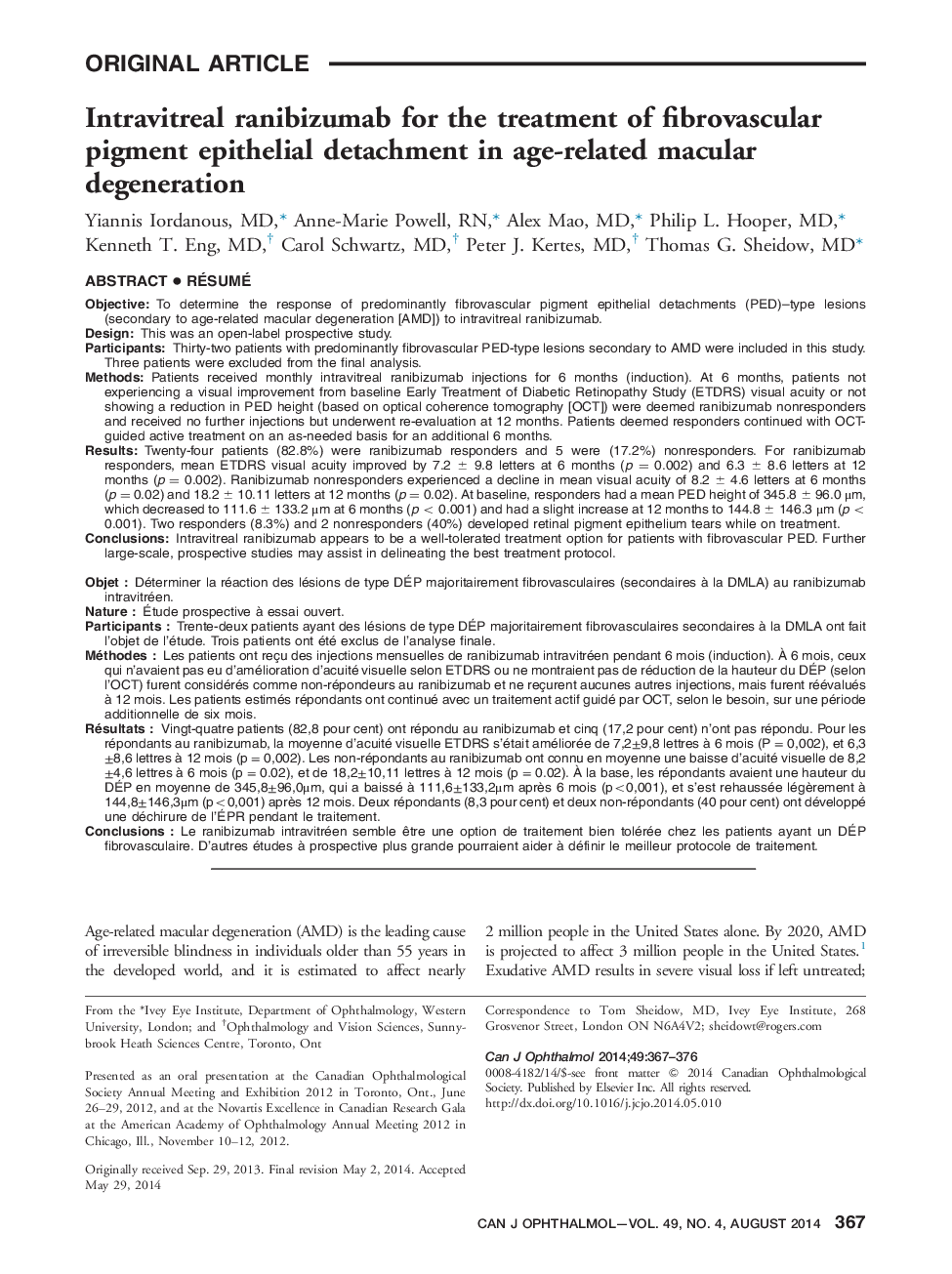| کد مقاله | کد نشریه | سال انتشار | مقاله انگلیسی | نسخه تمام متن |
|---|---|---|---|---|
| 4009324 | 1602402 | 2014 | 10 صفحه PDF | دانلود رایگان |

ObjectiveTo determine the response of predominantly fibrovascular pigment epithelial detachments (PED)–type lesions (secondary to age-related macular degeneration [AMD]) to intravitreal ranibizumab.DesignThis was an open-label prospective study.ParticipantsThirty-two patients with predominantly fibrovascular PED-type lesions secondary to AMD were included in this study. Three patients were excluded from the final analysis.MethodsPatients received monthly intravitreal ranibizumab injections for 6 months (induction). At 6 months, patients not experiencing a visual improvement from baseline Early Treatment of Diabetic Retinopathy Study (ETDRS) visual acuity or not showing a reduction in PED height (based on optical coherence tomography [OCT]) were deemed ranibizumab nonresponders and received no further injections but underwent re-evaluation at 12 months. Patients deemed responders continued with OCT-guided active treatment on an as-needed basis for an additional 6 months.ResultsTwenty-four patients (82.8%) were ranibizumab responders and 5 were (17.2%) nonresponders. For ranibizumab responders, mean ETDRS visual acuity improved by 7.2 ± 9.8 letters at 6 months (p = 0.002) and 6.3 ± 8.6 letters at 12 months (p = 0.002). Ranibizumab nonresponders experienced a decline in mean visual acuity of 8.2 ± 4.6 letters at 6 months (p = 0.02) and 18.2 ± 10.11 letters at 12 months (p = 0.02). At baseline, responders had a mean PED height of 345.8 ± 96.0 μm, which decreased to 111.6 ± 133.2 μm at 6 months (p < 0.001) and had a slight increase at 12 months to 144.8 ± 146.3 μm (p < 0.001). Two responders (8.3%) and 2 nonresponders (40%) developed retinal pigment epithelium tears while on treatment.ConclusionsIntravitreal ranibizumab appears to be a well-tolerated treatment option for patients with fibrovascular PED. Further large-scale, prospective studies may assist in delineating the best treatment protocol.
RésuméObjetDéterminer la réaction des lésions de type DÉP majoritairement fibrovasculaires (secondaires à la DMLA) au ranibizumab intravitréen.NatureÉtude prospective à essai ouvert.ParticipantsTrente-deux patients ayant des lésions de type DÉP majoritairement fibrovasculaires secondaires à la DMLA ont fait l’objet de l’étude. Trois patients ont été exclus de l’analyse finale.MéthodesLes patients ont reçu des injections mensuelles de ranibizumab intravitréen pendant 6 mois (induction). À 6 mois, ceux qui n’avaient pas eu d’amélioration d’acuité visuelle selon ETDRS ou ne montraient pas de réduction de la hauteur du DÉP (selon l’OCT) furent considérés comme non-répondeurs au ranibizumab et ne reçurent aucunes autres injections, mais furent réévalués à 12 mois. Les patients estimés répondants ont continué avec un traitement actif guidé par OCT, selon le besoin, sur une période additionnelle de six mois.RésultatsVingt-quatre patients (82,8 pour cent) ont répondu au ranibizumab et cinq (17,2 pour cent) n’ont pas répondu. Pour les répondants au ranibizumab, la moyenne d’acuité visuelle ETDRS s’était améliorée de 7,2±9,8 lettres à 6 mois (P = 0,002), et 6,3±8,6 lettres à 12 mois (p = 0,002). Les non-répondants au ranibizumab ont connu en moyenne une baisse d’acuité visuelle de 8,2±4,6 lettres à 6 mois (p = 0.02), et de 18,2±10,11 lettres à 12 mois (p = 0.02). À la base, les répondants avaient une hauteur du DÉP en moyenne de 345,8±96,0μm, qui a baissé à 111,6±133,2μm après 6 mois (p<0,001), et s’est rehaussée légèrement à 144,8±146,3μm (p<0,001) après 12 mois. Deux répondants (8,3 pour cent) et deux non-répondants (40 pour cent) ont développé une déchirure de l’ÉPR pendant le traitement.ConclusionsLe ranibizumab intravitréen semble être une option de traitement bien tolérée chez les patients ayant un DÉP fibrovasculaire. D’autres études à prospective plus grande pourraient aider à définir le meilleur protocole de traitement.
Journal: Canadian Journal of Ophthalmology / Journal Canadien d'Ophtalmologie - Volume 49, Issue 4, August 2014, Pages 367–376